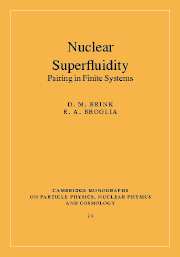Book contents
- Frontmatter
- Contents
- Preface
- 1 Introduction
- 2 The pairing force and seniority
- 3 The BCS theory
- 4 Spontaneous symmetry breaking
- 5 Pairing vibrations
- 6 Phase transitions
- 7 Plastic behaviour of nuclei and other finite systems
- 8 Sources of pairing in nuclei
- 9 Beyond mean field
- 10 Induced interaction
- 11 Pairing in exotic nuclei
- Appendix A A brief résumé of second quantization
- Appendix B Single particle in a non-local potential
- Appendix C Useful relations in the treatment of collective modes
- Appendix D Particle-vibration coupling
- Appendix E Model of the single-particle strength function
- Appendix F Simple model of Pauli principle corrections
- Appendix G Pairing mean-field solution
- Appendix H Pairing in a single j-shell
- Appendix I Fluctuations and symmetry restoration
- Appendix J RPA solution of the pairing Hamiltonian
- Appendix K Vortices in nuclei
- Appendix L Josephson effect
- References
- Index
Appendix L - Josephson effect
Published online by Cambridge University Press: 17 August 2009
- Frontmatter
- Contents
- Preface
- 1 Introduction
- 2 The pairing force and seniority
- 3 The BCS theory
- 4 Spontaneous symmetry breaking
- 5 Pairing vibrations
- 6 Phase transitions
- 7 Plastic behaviour of nuclei and other finite systems
- 8 Sources of pairing in nuclei
- 9 Beyond mean field
- 10 Induced interaction
- 11 Pairing in exotic nuclei
- Appendix A A brief résumé of second quantization
- Appendix B Single particle in a non-local potential
- Appendix C Useful relations in the treatment of collective modes
- Appendix D Particle-vibration coupling
- Appendix E Model of the single-particle strength function
- Appendix F Simple model of Pauli principle corrections
- Appendix G Pairing mean-field solution
- Appendix H Pairing in a single j-shell
- Appendix I Fluctuations and symmetry restoration
- Appendix J RPA solution of the pairing Hamiltonian
- Appendix K Vortices in nuclei
- Appendix L Josephson effect
- References
- Index
Summary
Josephson (1962) proposed that there should be a contribution to the current through an insulating barrier between two superconductors which would behave like direct tunnelling of condensed pairs from one condensed gas of bound pairs at the Fermi surface to the other. The measurement of such an effect has provided a beautiful scenario where the collective rotational degree of freedom in gauge space manifests itself, let alone some of the most accurate measurements of the electron charge (Anderson (1964)).
Before proceeding further let us briefly discuss a technical detail which, aside from being essential to microscopically understanding the mechanism which is at the basis of the effect, also clarifies the long-range order induced by pairing correlations. Because one is interested in calculating the tunnelling of Cooper pairs across the barrier separating the two superconductors, it is natural to start by assuming that it is the pairing interaction that is the source of this transfer, by annihilating a pair in superconductor 2 and creating a pair in superconductor 1 (see Fig. L.1). Although this is what effectively happens, it can be shown that the pairing interaction leads to a negligible contribution to pair transfer, and that essentially all the transfer proceeds through the single-particle mean field acting twice. Note that this reaction mechanism leading to a (successive) two-particle tunnelling does not destroy the correlation existing between the pair of fermions of a Cooper pair participating in the condensate.
- Type
- Chapter
- Information
- Nuclear SuperfluidityPairing in Finite Systems, pp. 356 - 360Publisher: Cambridge University PressPrint publication year: 2005

